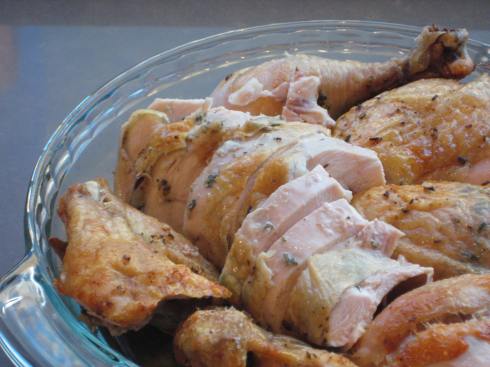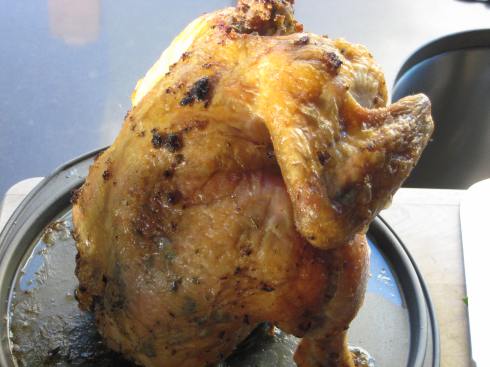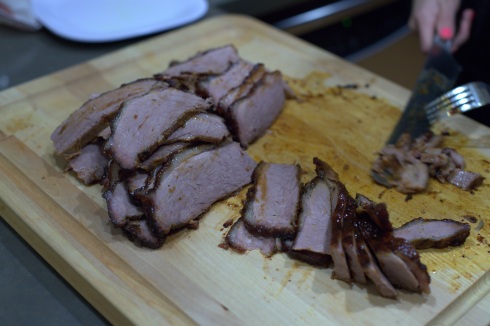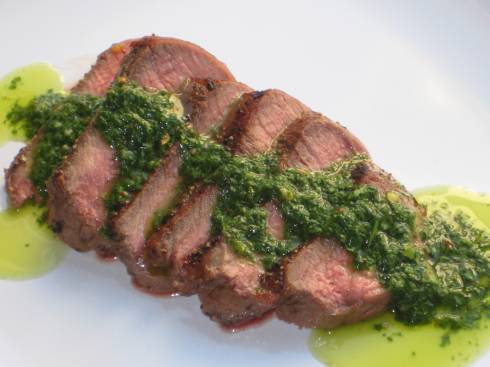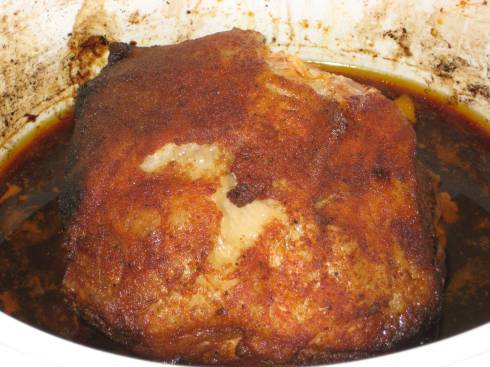You are currently browsing the category archive for the ‘Meat’ category.
Once you see the photo that follows, you will think I am totally corny for the naming the title of this post. The truth is, though, that this is just straight up, good roast chicken. I debated whether to even post the recipe since it’s so straight forward and simple and so many people already know how to roast a chicken. But if you are one of those who could use a little help, read on.
I used to be a huge fan of the rotisserie chicken at Costco. It was so convenient to stop in after work, pick one up and have dinner ready in no time. The chicken was always tender and flavorful and I wish I knew what Costco uses to season it. The best part was how cheap it was – you could get several meals for two people out of one bird for less than $5. But cheap meat probably isn’t the healthiest kind, so now I make my own. It’s easy to do, doesn’t require much preparation and the cooked chicken can be used in so many different ways. After a meal of roast chicken, I use the leftovers for chicken salad, throw it in a frittata, add it to some lettuce wraps, make soup with it, or just eat it cold out of the fridge. It makes such a regular appearance in my kitchen that, like other things I cook a lot, I don’t really measure anything out any more. Honestly, it’s tough to mess this one up but I have provided some guidelines on the ingredients.
I prefer to roast a whole chicken, as opposed to one that is cut up, because you get more flavor with a whole bird. The skin and bones also keep the chicken from drying out during the cooking process. I roast my chicken by standing it up using something similar to this thing. It’s based on the beer can chicken and it’s great because it lets the fat and liquid drip away and keeps the skin crispy. The canister in the middle can be filled with beer, wine, stock or liquid of your choice and it helps to steam the chicken from the inside. Add some bay leaves, lemon or garlic to the liquid and it adds even more flavor.
Makes 1 chicken, feeds about 4 people
1 4 to 5-pound organic whole chicken, room temperature
1 teaspoon fresh rosemary, minced
1 teaspoon fresh thyme, minced
1 teaspoon fresh parsley, minced
1 tablespoon salt
1 tablespoon Trader Joe’s 21 Seasoning Salute (or your favorite herb seasoning)
1 cup of beer, wine, or chicken stock
Bacon drippings (or your choice of fat), melted
- Preheat the oven to 375 degrees F.
- Combine the rosemary, thyme, parsley, salt and herb seasoning in a small bowl and mix well.
- Pour the beer/wine/stock into the center canister of the vertical chicken roaster.
- Rinse the chicken inside and out and pat dry with paper towel. Removing excess moisture will ensure a crisp skin.
- Separate the skin from the flesh of the chicken on the breast, thighs, and back. Be sure to do this gently without breaking the skin.
- Brush or rub bacon drippings on the outside of the chicken and in between the skin.
- Rub the herb and salt mixture in between the skin and on the outside of chicken so it’s well coated.
- Place chicken vertically on the chicken roaster and tuck tips of wings under so they won’t burn.
- Place roaster in oven and cook for 45 minutes to 1 hour or until the internal temperature reads at least 170 degrees F.
- Let chicken rest for 15 to 20 minutes before carving.
Growing up, my mom would make ox tail soup regularly in the winter. While I liked the soup enough, the ox tail itself was not that memorable. There was a little bit of meat and lots of bone. It was a good way to make flavorful broth for not a lot of money. Fast forward a few years and I have rediscovered the ox tail. Except now I enjoy it as a stew that can be made in either the oven or on the stove. Like the pulled pork or brisket recipes, this one requires a longer cooking time but it’s very much worth it in the end. The ox tail I get is pretty meaty and also fairly fatty and I would definitely recommend trimming the fat before cooking. While I typically like keeping some fat, having too much of it just makes the whole dish oily.
Braised Ox Tail
Serves 6
4 pounds grass-fed ox tail, cut into 2-inch sections
1/2 to 3/4 cup red wine
2 to 3 tablespoons Trader Joe’s 21 Seasoning Salute
2 tablespoons tomato paste
4 – 6 roma tomatoes, chopped
2 medium onions, chopped
4 carrots, chopped
4 to 5 ribs celery, chopped
3 cloves garlic, chopped
1 cup frozen peas
2 teaspoons himalayan salt
1 teaspoon ground black pepper
1 bay leaf
Rinse and pat dry ox tail pieces. Trim fat if necessary. Sprinkle ox tail with a couple pinches of salt and a pinch of black pepper.
Oven
- Set oven to broil and place ox tail on roasting pan or baking dish.
- Broil ox tail for 5 – 6 minutes. Turn pieces over and broil another 5 to 6 minutes, until exterior looks crispy and brown.
- Remove from oven and transfer to plate. Drain excess fat from pan or dish.
- Turn oven down to 375 degrees F.
- Mix tomato paste, red wine, salt and pepper and set aside.
- Place tomatoes, onions, carrots, celery, garlic and bay leaf on the bottom of the pan or dish then add the browned ox tail.
- Sprinkle the 21 Seasoning Salute ( or your favorite mix of herbs) over the meat and pour the wine mixture over everything.
- Roast covered for 2 1/2 hours.
- Uncover and stir in peas. Cook for another 30 minutes.
Stove top
- Heat cast-iron dutch oven over medium heat with 1 tablespoon coconut oil or grapseed oil.
- Place ox tail in dutch oven to brown and sear for about 5 minutes.
- When meat releases from oven bottom easily, turn over and sear another 4-5 minutes.
- Add onions, carrots, and celery and cook for a few minutes until vegetables begin to soften.
- Deglaze pot with red wine and add remaining ingredients, except peas, to pot and cover pot.
- Cook for 2 1/2 to 3 hours on the stove over low heat. Check periodically and add 1/2 cup water or beef stock at a time if mixture looks dry.
- Ox tail is done when the meat separates easily from the bone with a fork.
- Add peas and cook for another 5 to 10 minutes.
- Remove bay leaf and serve.
If you’re looking for an ox tail recipe with Asian flavor, check out Sunday Nite Dinner. There are any number of ways to cook ox tail and they all end with a hearty and satisfying meal.
I used to be a vegetarian. For ten years. Between graduating college and getting married, I ate no meat. Well, not real meat. I ate lots of meat substitutes and soy meats, stuff that I won’t touch today. Today, I eat lots of real meat and whole foods and my diet is unrecognizable from the one I had a decade ago. I went from an omnivore to a vegetarian overnight but the transition back was much more gradual. Once I realized that I wasn’t getting the nutrition I needed, I started to incorporate animal proteins one at a time. First came fish, then chicken, then beef. I refrained from eating pork for a long time because I didn’t like where most pork came from. Having worked for a large grocer, I’d seen first hand where the spoiled deli meats and produce went – the hog farms. Pretty nasty.
We’ve since found a reliable source of quality pastured pork and are enjoying all kinds of piggy products now. Just a few nights ago, we had some juicy pork chops. Because the chops I get are usually thick, I’ve learned that brining is the best way to get a lot flavor and keep them moist. I found a great site on preparing and cooking meat and I used the basic brining recipe that is very adaptable. I didn’t have any chicken stock on hand, so I used water and increased the apple cider vinegar.
Brined Pork Chops (adapted from How to Cook Meat)
Serves 4
4 loin pork chops
2 cups water
1/4 cup sea salt
1/4 cup maple syrup
1 teaspoon black peppercorns
1 teaspoon ground sage
2 bay leaves
2 tablespoons apple cider vinegar
2 cups ice water
- Combine everything except the ice water in a saucepan and heat on low just until the salt dissolves.
- Remove from heat and add the ice water. Let brine cool.
- Place cooled brine in gallon-sized zip top bag and add chops. Place bag in a large dish in case bag leaks.
- Refrigerate for 2 to 8 hours.
- Remove chops and pat dry. Discard brine.
- Grill chops to desired doneness then let rest for 5 to 10 minutes before serving.
I always ask hubby, the in-house grill master, to leave the chops just slightly pink in the middle. Unlike steak, we don’t eat our pork underdone but to have a dry, overcooked piece of meat is criminal. The great thing about brining is that even if you leave them on the grill a bit longer, you’ll find that the brine really helps keep the chops tender and juicy. Hope you’ll try it.
Steak makes a regular appearance at our dinner table. It requires little preparation and with my husband doing the cooking on the grill, I am spared to do other leisurely things – enjoy a glass of wine, flip through a glossy magazine or, most likely, pick up the toys and sippy cups strewn about the floor for the nth time.
In choosing a cut, I usually favor rib eye for the flavor and the fat but we also like flat iron as it’s quite tender. Last night, I made a chimichurri sauce to go with our steaks. The sauce is zingy and fresh and pairs really well with not only grilled beef but chicken as well. An authentic Argentinian recipe calls for parsley to be used in chimichurri but I have used cilantro with fantastic results. If you like garlic, this is the sauce for you.
Chimichurri with Grilled Rib Eye
2 rib eye steaks
1/4 cup worcestershire sauce
salt & pepper
1 bunch parsley, chopped
1 tablespoon fresh orgeno, chopped
6 garlic cloves, chopped
3/4 cup olive oil
1/4 cup red wine vinegar
1 teaspoon red pepper flakes
2 teaspoons salt
1 teaspoon black pepper
- Marinate steaks in worcestershire and sprinkle with salt and pepper. Let sit for 30 minutes then grill to your liking (medium rare for me).
- Whisk together all ingredients for sauce and serve along side steaks.
- Store any unused sauce in the refrigerator.
The sauce is best prepared by chopping the garlic and herbs by hand. A blender can be used but be sure not to blitz it for too long otherwise it will all look like green soup.
One of the best kitchen gadgets ever invented is the slow cooker. It has helped me to prepare countless meals with minimal effort it’s almost ridiculous. It is the perfect tool for primal cooking because it really showcases the quality and flavor of the ingredients. In this case, the star ingredient is the pork. When you use a good piece of meat, very little else is required for the flavors to shine through. If you choose to season it, almost any type will do – dry rubs, herbs, or the stand by salt and pepper. I used a pork shoulder roast that had a good layer of fat intact and, boy, was that yummy.
With slow cooking, time is your friend. And for a busy mom, passive cooking time is the best kind. Just turn it on and walk away. Walk towards that pile of laundry, or dirty diaper pail, or the screaming kid on the floor, or the the hungry cat and dog that have been staring you down since the night before.
Easy Pulled Pork
1 organic, pastured pork shoulder roast, 3 to 4 pounds
3 – 4 tablespoons dry rub mix (I used paprika, garlic powder, onion powder, cumin, coconut sugar, salt & pepper)
- Start with the roast that has been pat dry. Rub seasoning mix to coat.
- Place roast in slow cooker with the fat on top.
- Cook roast on low for at least 8 to 10 hours.
The resulting dish is tender, juicy, and unctuous with all that sticky, flavorful fat. The pork creates all the liquid it will cook in and there is enough meat for plenty of meals. We have had it with grilled veggies for dinner and the leftovers were eaten with some barbeque sauce in pulled pork sandwhiches. I also add it to eggs and top with salsa for a tasty, filling breakfast.

